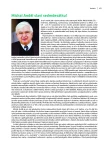Growth hormone, axis GH-IGF1 and glucose metabolism
Authors:
Michal Kršek
Authors‘ workplace:
II. interní klinika 3. LF UK a FN Královské Vinohrady, Praha
Published in:
Vnitř Lék 2016; 62(Suppl 4): 62-66
Category:
Reviews
Overview
Growth hormone is a hormone of anterior lobe of pituitary gland which possesses besides its growth promoting effects also many other various physiological effects including its regulatory influences on metabolism with glucose metabolism belonging to most important ones. The present article summarizes basic information about metabolic consequences of disturbed growth hormone secretion and their importance for clinical presentation and management.
Key words:
acromegaly – glucose – growth hormone – growth hormone deficiency – IGF1 – metabolism
Sources
1. Raben M. Growth hormone. N Engl J Med 1962; 266 : 31–35.
2. Hossay BA. The hypophysis and metabolism. N Engl J Med 1936; 214 : 961–985.
3. Ikkos D, Luft R, Gemzell C et al. Effect of human growth hormone in hypophysectomised diabetic subjects. Lancet 1958; 1(7023): 721–722.
4. Rabinowitz D, Klassen GA, Zierler KL. Effects of human growth hormone on muscle and adipose tissue metabolism in the forearm of men. J Clin Invest 1965; 44 : 51–61.
5. Bak JF, Moller N, Schmitz O. Effects of growth hormone on fuel utilization and muscle glykogen synthase activity in normal humans. Am J Physiol 1991; 260(5 Pt 1): E736-E742.
6. Orskov L, Schmitz O, Jorgensen JO et al. Influence of growth hormone on glucose induced glucose uptake in healthy men as assessed by hyperglycaemic clamp technique. J Clin Endocrinol Metab 1989; 68(2): 276–282.
7. Nielsen S, Moller N, Christiansen JS et al. Effects of growth hormone on insulin sensitivity and forearm metabolism in normal men. Diabetologia 1989; 32(2): 105–110.
8. Tanner JM, Hughes PCR, Whitehouse RH. Comparative rapidity of response of height, limb muscle and limb fat to treatment with growth hormone in patients with and without growth hormone deficiency. Acta Endocrinol (Copenh) 1977; 84(4): 681–696.
9. Olšovská H, Šiprová H, Beránek M et al. The influence of long-term growth hormone replacement therapy on body composition, bone tissue and some metabolic parameters in adults with growth hormone deficiency. Vnitř Lék 2005; 51(12): 1356–1364.
10. Brisenden JE, Ulrich A, Francke U. Human chromozomal mapping of genes for insulin-like growth factors I and II and epidermal growth factor. Nature 1984; 310(5980): U781-U784.
11. Baserga R, Rubin R. Cell cycle and growth control. Crit Rev Eucaryotic Gene Expression 1993; 3(1): 47–61.
12. Cohick WS, Clemmons DR. The insulin-like growth factors. Ann Rev Physiol 1993; 55 : 131–153.
13. Muta K, Krantz SB. Apoptosis of human erythroid colony forming cells is decreased by stem cell factor and insulin-like growth factor I as well as erythropoietin. J Cell Physiol 1993; 156(2): 264–271.
14. Sara V, Hall K. Insulin-like growth factors and their binding proteins. Physiol Rev 1990; 70(3): 591–614.
15. Giudice LC. Insulin-like growth factors and ovarian follicular development. Endocr Rev 1992; 13(4): 641–669.
16. Penhoat A, Jaillard C, Saez JM. Synergistic effects of corticotropin and insulin-like growth factor I on corticotropin receptors and corticotropin responsiveness in cultured bovine adrenocortical cells. Biochem Biophys Res Commun 1989; 165(1): 355–359.
17. Jacob RJ, Barrett E, Plewe G et al. Acute effects of insulin-like growth factor-1 on glucose and amino acid metabolism in the awake fasted rat. J Clin Invest 1989; 83(5): 1717–1723.
18. Jones JI, Clemmons DR. Insulin-like growth factors and their binding proteins: biological actions. Endocrine Rev 1995; 16(1): 3–34.
19. Fernandez A, Karavitaki N, Wass JA. Prevalence of pituitary adenomas: a community-based, cross-sectional study in Banbury (Oxfordshire, UK). Clin Endocrinol (Oxf) 2010; 72(3): 377–382. Dostupné z DOI: <http://dx.doi.org/10.1111/j.1365–2265.2009.03667.x>.
20. Melmed S, Casanueva FF, Klibanski A et al. A consensus on the diagnosis and treatment of acromegaly complications. Pituitary 2013; 16(3): 294–302. Dostupné z DOI: <http://dx.doi.org/10.1007/s11102–012–0420-x>.
21. Kršek M. Akromegalie a gigantismus. Postgraduální medicína 2011; 13(4): 360–367.
22. Šilha JV, Kršek M, Hána V et al. Perturbations in adiponectin, leptin and resistin levels in acromegaly: lack of correlation with insulin resistance. Clin Endocrinol 2003; 58(6): 736–742.
23. Frara S, Maffezzoni F, Mazziotti G et al. Current and emerging aspects of diabetes mellitus in acromegaly. Trends Endocrinol Metab 2016; 27(7): 470–483. Dostupné z DOI: <http://dx.doi.org/10.1016/j.tem.2016.04.014>.
24. Kaiser U, Ho KK. Pituitary physiology and diagnostic evaluation. In: Melmed S, Polonsky KS, Reed Larsen P et al. Williams Textbook of Endocrinology. 13th ed. Elsevier: Philadelphia (PA): 2015 : 176–231. ISBN 978–0323297387.
25. Carroll PV, Christ ER, Bengtsson BA et al. Growth hormone deficiency in adulthood and the effects of growth hormone replacement: a review. J Clin Endocrinol Metab 1998; 83(2): 382–395.
26. Molitch ME, Clemmons DR, Malozowski S et al. Evaluation and treatment of adult growth hormone deficiency: an Endocrine Society clinical practice guideline. J Clin Endocrinol Metab 2002; 87(5): 2067–2079.
Labels
Diabetology Endocrinology Internal medicineArticle was published in
Internal Medicine

2016 Issue Suppl 4
Most read in this issue
- Congenital hyperinsulinism: Loss of B-cell self-control
- Gestational Diabetes Mellitus
- Growth hormone, axis GH-IGF1 and glucose metabolism
- Education of a patient with diabetes – an integral part of complex therapy
